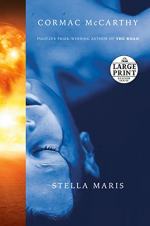|
This section contains 750 words (approx. 2 pages at 400 words per page) |

|
Stella Maris Summary & Study Guide Description
Stella Maris Summary & Study Guide includes comprehensive information and analysis to help you understand the book. This study guide contains the following sections:
This detailed literature summary also contains Quotes and a Free Quiz on Stella Maris by Cormac McCarthy.
The following version of this book was used to create the guide: McCarthy, Cormac. Stella Maris. Alfred A. Knopf, 2022.
Stella Maris consists of a series of seven conversations between Alicia Western, a deeply troubled and pessimistic mathematical savant, and Dr. Michael Cohen, a psychologist who is treating her at Stella Maris, a psychiatric care center in Black River Falls, Wisconsin. The two converse over an undisclosed amount of time, beginning in the autumn of 1972. Aside from a very brief prefatory note describing the setting and Alicia’s case history, the text of the novel consists only of dialogue between Alicia and Dr. Cohen, with no supplemental or contextual descriptions. The prefatory note identifies Stella Maris as “a non-denominational facility and hospice for the care of psychiatric patients” and also includes a brief case study describing Alicia’s situation: she is twenty years old, working on a PhD in Mathematics at the University of Chicago, and “has been diagnosed as a paranoid schizophrenic.” Her case summary also reveals that she had been a patient at Stella Maris twice in the past, and that she arrived with a large amount of cash.
In Chapter 1, Alicia reveals that she came to Stella Maris from Italy, where her brother, a race-car driver named Bobby, is in a coma. The medical authorities sought Alicia’s permission to end Bobby’s life support, and she flees the country before granting permission. She regards her brother as dead. She tells Dr. Cohen in no uncertain terms that she does not wish to discuss him in their conversations, a determination that wanes throughout the novel. She does readily discuss mathematics and Topos theory, the subset of math in which she was at one time working on a thesis. She reveals she was invited to study at an advanced institute in Europe - the IHES - by Alexander Grothendieck, one of the most prominent mathematicians of the twentieth century. Grothendieck and Alicia ultimately consider themselves mathematical skeptics, having reached a plane of understanding in mathematics that forces slippery metaphysical considerations of reality, a central theme of the novel.
Alicia also reveals that she has regular hallucinations of recurring characters, although she consistently rejects the term hallucination, and insists that the figures she sees are substantively real, at least to her. The main recurring figure she sees is named The Thalidomide Kid, who is short and bald and has flippers in the place of hands, and employs odd, garish speech. Early in their conversations, Alicia reveals herself as highly troubled, and highly intelligent.
Early chapters dwell especially on Alicia’s family and upbringing. In addition to being a mathematical prodigy, she is musically gifted, and has synesthesia. Both her parents died of cancer when she was young (her mother when she was eleven, and her father when she was fifteen). Both worked on the development of the atomic bomb, and her father was a principal physicist on the Manhattan Project, who worked closely with Robert Oppenheimer. She was raised by her grandmother in Tennessee before leaving for college at 14. She graduated in two years and was admitted into the doctoral program at the University of Chicago, though following her undergraduate years she drove to Tucson and worked in a bar at night while working on advanced math problems during the day. Around this time, Bobby had uncovered a stash of gold coins in their grandparents’ basement, and gave Alicia half the money, a substantial sum that she used to purchase a historically significant violin.
In addition to discussing Alicia’s family and mathematical theories, Alicia and Dr. Cohen also discuss dreams, the unconscious, and the possible existence of God. Alicia feels a design and malignant intentionality in the universe, and claims to have had a vision of a dark power operating at the heart of the world, which she calls The Archatron. In later chapters, she begins to disclose more about her brother Bobby, including the troubling revelation that she was in love with him, and wanted a physical, intimate relationship - to the point that she wanted to marry him and have his child. Bobby rejected her advances when she was younger, a development from which she never recovered. She consistently shares bleak, pessimistic views of the world, regarding war and ultimately apocalypse as near-certainties. She shares detailed thoughts about suicide, and ends their conversations by sharing a fantasy of dying in a remote mountain village in Romania, never receiving a diagnosis from Dr. Cohen.
Read more from the Study Guide
|
This section contains 750 words (approx. 2 pages at 400 words per page) |

|



